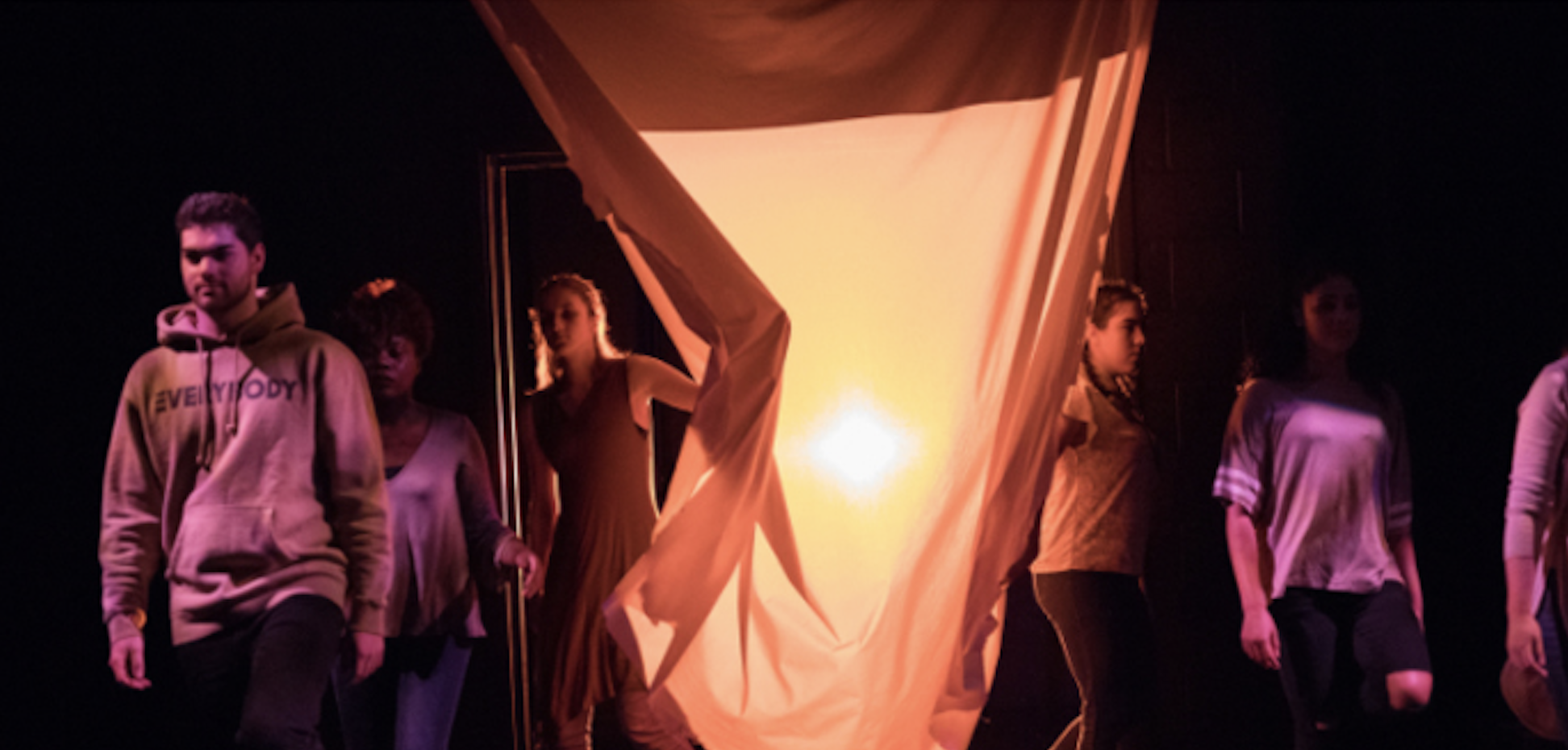
Assessment
The Working Group assessed students' engagement with diversity and social justice learning in the classroom, particularly in areas and dimensions identified in the Diversity ILG Continuum. In Spring 2021, a survey was designed and disseminated to students enrolled in Common Academic Program Diversity and Social Justice (DSJ) courses.
Scope
Identifying DSJ Dimensions
Students were asked to rate their knowledge of the Diversity ILG Learning Continuum dimensions: Bias, Intercultural Competence, Intersectionality, and Social Justice.
Linking to Coursework
Students were asked to link these learning dimensions to coursework by identifying impactful course activities and explaining how they helped develop these skills.
Connecting to Experiences
Students were invited to reflect on whether/how/where they have applied this knowledge of diversity and social justice dimensions in life experiences outside their classrooms.
Findings: In a Nutshell
Courses & Demographics
All 60 faculty teaching 57 DSJ courses (77 sections) in Spring 2021 were invited to participate, and 23 elected to disseminate the assessment in 18 courses (23 sections) yielding a total of 340 student answers at 62% response rate. The findings highlighted in this section aim to provide in a nutshell some key takeaways from the assessment centering student learning experiences and exploring opportunities for CAP DSJ faculty development. Students represented academic units as follows: 60% CAS | 20% HSS | 14% SBA | 6% SOE
Identifying DSJ Dimensions
Utilizing the Diversity ILG Learning Continuum’s dimensions and the learning levels associated with them, students were asked to self-assess their learning and skills at the beginner, intermediate and advanced levels. Overall, DSJ courses are successfully achieving various levels of the learning objectives articulated in the Continuum which incentivizes intentionally utilizing the dimensions as a framework for DSJ course design, development and implementation.
Linking DSJ Dimensions to Coursework
When describing a course experience that most impacted their DSJ learning, these categories surfaced as the top 5 responses: 37% Class discussions | 21% Readings | 15% Current Events | 12% Project or Assignment | 11% Hearing about others’ experiences, thoughts and interactions across difference. Two general categories of topics stood out as prevalent across many courses: (1) Race and ethnicity in the U.S. and particularly Black and African American experiences; and (2) experiences of groups outside the U.S. and focus on international dynamics such as immigration.
Continuum Dimensions in Practice
When describing an experience in which these dimensions were used, these categories surfaced as the top 5 responses: 21% Class discussions | 20% Non-class discussions | 17% Self-reflection | 13% Class readings | 8% Multicultural interactions. While classrooms offered more structured formats, non-class discussions with roommates, family members, and friends were listed as important opportunities to not only apply what they learned, but to educate others, challenge their peers to question assumptions or biases, or to dig more deeply into topics to which they had been introduced in class.
Where does DSJ Learning Occur?
Given the diverse curricular and (co)-offerings and the nature of our residential campus, understanding the landscape of spaces in which DSJ learning may occur is critical to examine closely how the Continuum could be utilized in such venues and strengthen all efforts going into a scaffolded learning approach. These categories surfaced as the top 5 responses: 50% Coursework (25% CAP) | 23% Housing & Residence Life | 10% Student Engagement | 6% Athletics, Centers, Institutes and Circles | 5% (Co)-Curricular.
Challenges Pertaining to DSJ Learning
Our students are sensitive to the nature of DSJ conversations, particularly in light of campus climate and ongoing events shaping national and global narratives. When asked to raise any concerns and identify what challenges them the most, these surfaced as the top 5 categories: 28% Understand/Work through Difference and Privilege | 13% Campus Climate and Culture of Indifference | 10% Apply, Action, Impact, Solution and Change | 10% Time, Conversation and Engagement | 6% Pedagogy
All 60 faculty teaching 57 DSJ courses (77 sections) in Spring 2021 were invited to participate, and 23 elected to disseminate the assessment in 18 courses (23 sections) yielding a total of 340 student answers at 62% response rate. Colleagues who opted-in will receive a course-level results report and partake in a Spring 2022 workshop part of the CAP DSJ-Hangouts to help interpret the results, reflect on lessons learned, and explore how to enhance DSJ student learning.
Students who completed the survey opted to take the assessment either during allocated course time or on their own per instructor’s request. This sample reflects a diverse demographic in terms of classification and field of study enrollment per school or college.
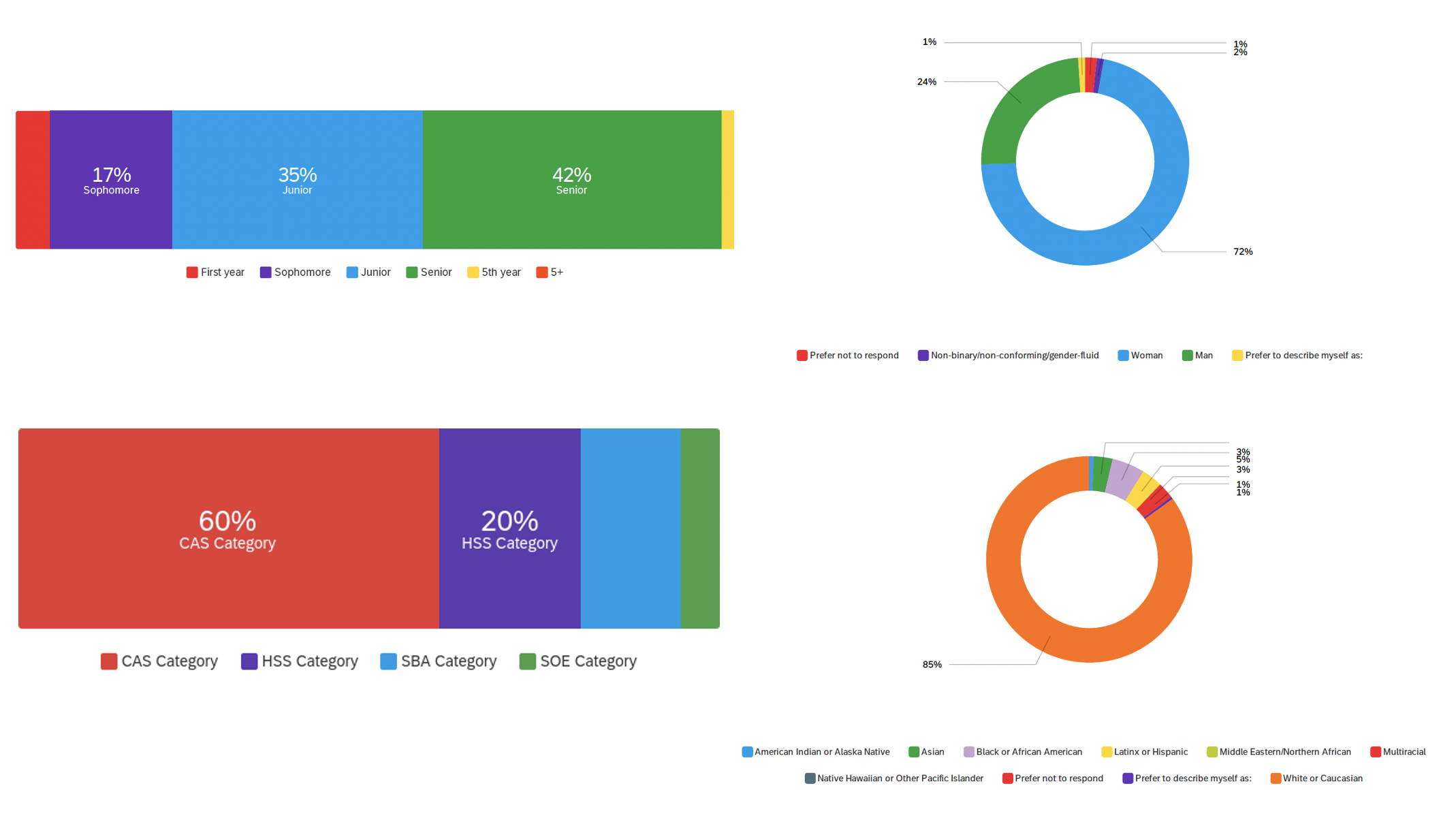
Identifying Diversity & Social Justice Dimensions
Utilizing the Diversity ILG Learning Continuum’s dimensions and the learning levels associated with them, students were asked to self-assess their learning and skills at the beginner, intermediate and advanced levels. This matrix presents the overall findings, but this series of spreadsheets contextualizes how each question relates to the relevant Continuum dimension and its levels of achievement.
A couple of observations to reflect on:
- DSJ courses are successfully achieving various levels of the learning objectives articulated in the Continuum. This should reinforce the importance of adopting the Continuum’s dimensions as a framework for DSJ course design, development and implementation, and review.
- Mirroring this data with the demographics of students, particularly their classification (42% Seniors and 35% Junior standing students), the Continuum can be utilized as a realistic goal and measure to ensure that CAP DSJ courses offer advanced skills in diversity and social justice learning building on previous curricular and (co)-curricular opportunities during a UD student’s undergraduate education.
With an attempt to better understand the landscape of DSJ coursework practices, students were asked to identify which activities during the course incorporated the Continuum dimensions, and rate (on a scale 0-5) how impactful they were in terms of developing diversity and social justice competencies.
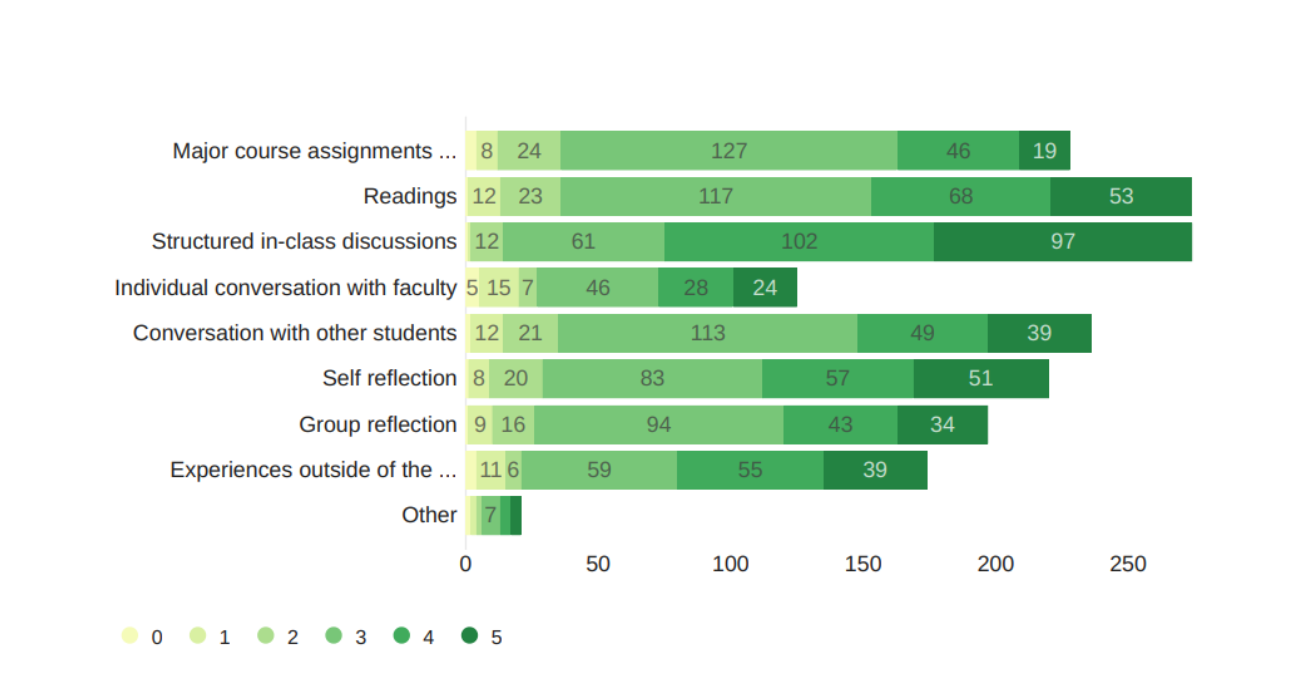
When asked to briefly describe one classroom experience that most impacted their diversity and social justice learning in the course, these categories (responses were coded into multiple categories) surfaced as the top five responses (percent of all respondents (n=220) to the question):
- 37% Class discussions
- 21% Readings
- 15% Current Events (Critical Evaluation of our Times)
- 12% Project or Assignment
- 11% Hearing about others’ experiences/thoughts and interactions across difference
Students were very complimentary of class discussions and of the impact of those experiences on their learning. As one student cogently put it: “I would say that our class discussions in general are particularly impactful in that they incorporate student perspectives into an elevated discussion/understanding of the reading and how it's relevant for diversity and social justice-- all of these elements come together cohesively best in class discussion I think.”
Many of the other top responses for this question surfaced alongside class discussions. For instance, students who mentioned course readings often did so in the context of talking about how their class discussions drew upon the course readings. Other students indicated that the courses used class discussions to apply historical or theoretical content to current events and students’ own experiences.
One important response dynamic that the list above does not communicate is that many students described a particular piece of content or topic rather than a type of learning experience. Because these topics varied by course it was difficult to thematically code in ways that did not replicate the course titles; however, two very general categories of topics stood out as prevalent across many courses:
- Race and ethnicity in the United States and particularly Black and African American experiences;
- Experiences of groups outside the United States and focus on international dynamics such as immigration.
As is often the case for similar appreciative inquiry questions, the praise for the quality of teaching was almost palpable in reading these responses. Below is a selection of comments that, while not intended to be representative, describe some of the contours of students’ overall very positive reflections on their experiences:
- Group discussions on race at the beginning of the semester was [sic] uncomfortable but really good.
- I think that anytime someone gave a personal example about something they had experienced was what impacted my diversity and social justice learning in this course.
- I would say the most impactful experience would be the conversations we have in the classroom. A lot of the topics we discuss are things that I would normally not have the opportunity to have a conversation about, so it was really nice to gain further perspective on issues I may have not personally faced.
- I am a science based major, therefore, I am in this class with people I typically would not be. Group discussions with those that are different than [sic] myself are very impactful in my learning.
- This happens every class, but just our discussions on the literature we read. Each reading has a new insight and our professor does a great job explaining the deeper meanings of our assigned readings. They are very applicable to everyday life.
- The connection papers were my favorite because I got to choose various events that were very current to what's going on now and connect it to our learnings.
- Discussing equity / inequality specifically looking at UD as a campus and community.
- I feel like my self reflection after doing readings has been the most impactful in understanding the actions of past cities that have led to some of the events that have recently occurred.
Whether by engaging in reflections, conversations or demonstrating techniques or utilizing tools to interrupt microaggressions and bias behaviors that adversely impact under-represented communities, students were asked to describe an experience in which they have used any of the Continuum dimensions. These categories (responses were coded into multiple categories) surfaced as the top five responses (percent of all respondents (n=163) to the question:
- 21% Class discussions
- 20% Non-class discussions
- 17% Self-reflection
- 13% Class readings
- 8% Multicultural interactions
Regardless of setting, discussions were named most frequently by students as the type of experience where they were able to apply what they had learned in relation to the DSJ dimensions outlined in the Continuum. While classroom discussions offered more structured formats and clearer connections to concepts covered in their coursework, non-class discussions with roommates, family members, and friends were also named by respondents. These were listed as important opportunities for students to not only apply what they learned, but to educate others, challenge their peers to question assumptions or biases, or to dig more deeply into topics to which they had been introduced in class. As one student stated:
“One experience that I used the DSJ dimensions in the first matrix was when I was talking [sic] with all of my friend group one night. We all got into a huge fight about exploring our own privileges and acknowledging the elephant in the room that we only had one black friend in our friend group, of whom was most of our friends' first black friend. While this conversation was more of a dispute I think I was able to be helpful and help guide the conversation in a better direction because of the courses and things I have learned within the CAP program.”
Many students also noted self-reflection as an important process that involved the application of DSJ dimensions. While engagement and interaction with others was clearly an opportunity to practice skills necessary to engage in challenging conversations, students demonstrated a knowledge of their own individual biases, privilege, and previously held ideas or beliefs around DSJ concepts. In some instances, that understanding spurred students to pursue further avenues of inquiry around these topics. Below is a selection of comments that reflect this understanding:
- I think now I am able to better understand my implicit biases and can better recognize them in group conversations and can think my [sic] empathetically when large social debates are occurring.
- Going into a new environment, instead of judging, I chose to understand and appreciate others’ backgrounds.
- Over the summer with the BLM protests and movements, I was able to examine my own implicit biases and privilege and society. Then, I was able to do something about it by listening to podcasts, reading articles, and watching documentaries to share my knowledge with people thus being a better ally and advocate.
The list of experiences mentioned above does not capture some of the specific thematic content around which such experiences were focused. Examinations of two particular Continuum dimensions surfaced in the comments: bias (9%) and privilege (12%), as an aspect of the dimension of intersectionality/power. These dimensions were clearly connected to the experience of self-reflection. As one respondent stated, “I was able to reflect and understand how implicit bias is seen in everyday things like resumes and job searching and how I would not be as likely to experience that as a white female than as a black female might.”
Given the diverse curricular and (co)-curricular offerings including the nature of our residential campus, better understanding the landscape of spaces and places in which DSJ learning may occur is critical not only to examine closely how the Continuum could be utilized in such venues but also to strengthen all efforts going into a scaffolded diversity learning approach.
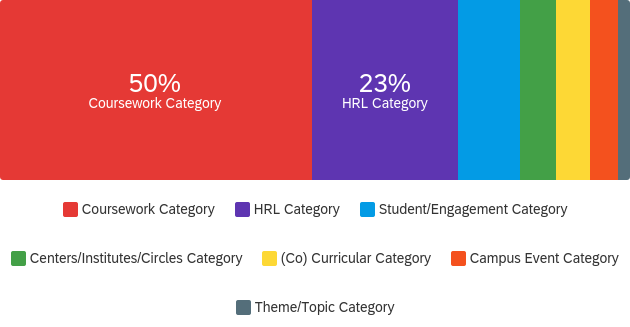
As the graph shows, all respondents (n=315) to the question resulted in these top five categories:
- 50% Coursework
- 23% Housing and Residence Life
- 10% Student Engagement
- 6% Athletics/Centers/Institutes/Circles
- 5% (Co)-Curricular
Coursework. Curriculum and classroom remain the primary source (50%) for DSJ learning according to these students. While not asked specifically to provide a course title or number, 25% of respondents identified specific courses that are meaningfully contributing to this experience, of which 15% are CAP designated courses including SSC 200 or Social Science Interdisciplinary (4%) for providing foundational work in this dimension.
“In classes, especially in the Core program, we would specifically discuss social justice and diversity and how we can better utilize our knowledge to address situations of inequity in society, especially with food deserts, voting rights, racism, discrimination, and much more.”
Family, Social, and Housing and Residence Life. While only 2% respondents identified stand-alone campus events and exhibits as a space for DSJ learning, Housing and Residence Life serves as a second DSJ learning nexus, encompassing Aviate/PATH events, residence hall/floor meetings, facilitated training and conversations as well as social times with friends, roommates and family.
“I have learned a lot about diversity and social justice in some of my psychology courses as well as in my current living situation with my roommates and having open discussions”.
“I have learned about it at home when talking to my sister and parents through dialogue. I also do my own research on the internet, looking at social media and reading articles online about topics I’m not fully aware of.”
Student Engagement. Separating Housing and Residence Life from their engagement on campus through student organizations and greek life, 10% of our respondents emphasized the value of such spaces as venues for DSJ learning. While many underscored the nature of hosting events, speakers or attending existing ones on campus, a few spoke of their role leading and facilitating such conversations for their units.
“I have learned an extensive amount about diversity and social justice through my sorority in serving on the diversity, equity and inclusion board. In this position I have done extensive research to prepare and resources and presentations for the entire chapter.”
Athletics/Centers/Institutes/Circles. The Multi-Ethnic Education and Engagement Center (MEC), Athletics and Campus Recreation, and Campus Ministry are the leading DSJ learning spaces in this category, showcasing a unique opportunity for strengthening the dimensions presented in the Continuum.
(Co)-Curricular Experiences. Whether working in dining halls such as VWK, in Campus Recreation or internships associated with their programs of study, students are engaging in learning opportunities through training in the workplace that contribute to better understanding diversity and social justice matters in practice. Events taking place on campus are also enriching these experiences.
“I have attended a few Black Lives Matter protests in which I focused on hearing those and educating myself on those experiences around people that do not look like me which was eye-opening as I, and my family were not the subject of the matter at hand.”
Our students are sensitive to the nature of diversity and social justice conversations, particularly in light of understanding our campus climate and following ongoing events shaping national and global narratives. When asked to raise any concerns or lingering questions they may have regarding their learning, and identify what challenges them the most as they learn about DSJ, these (responses were coded into multiple categories) surfaced as the top five responses (percent of all respondents (n=163) to the question:
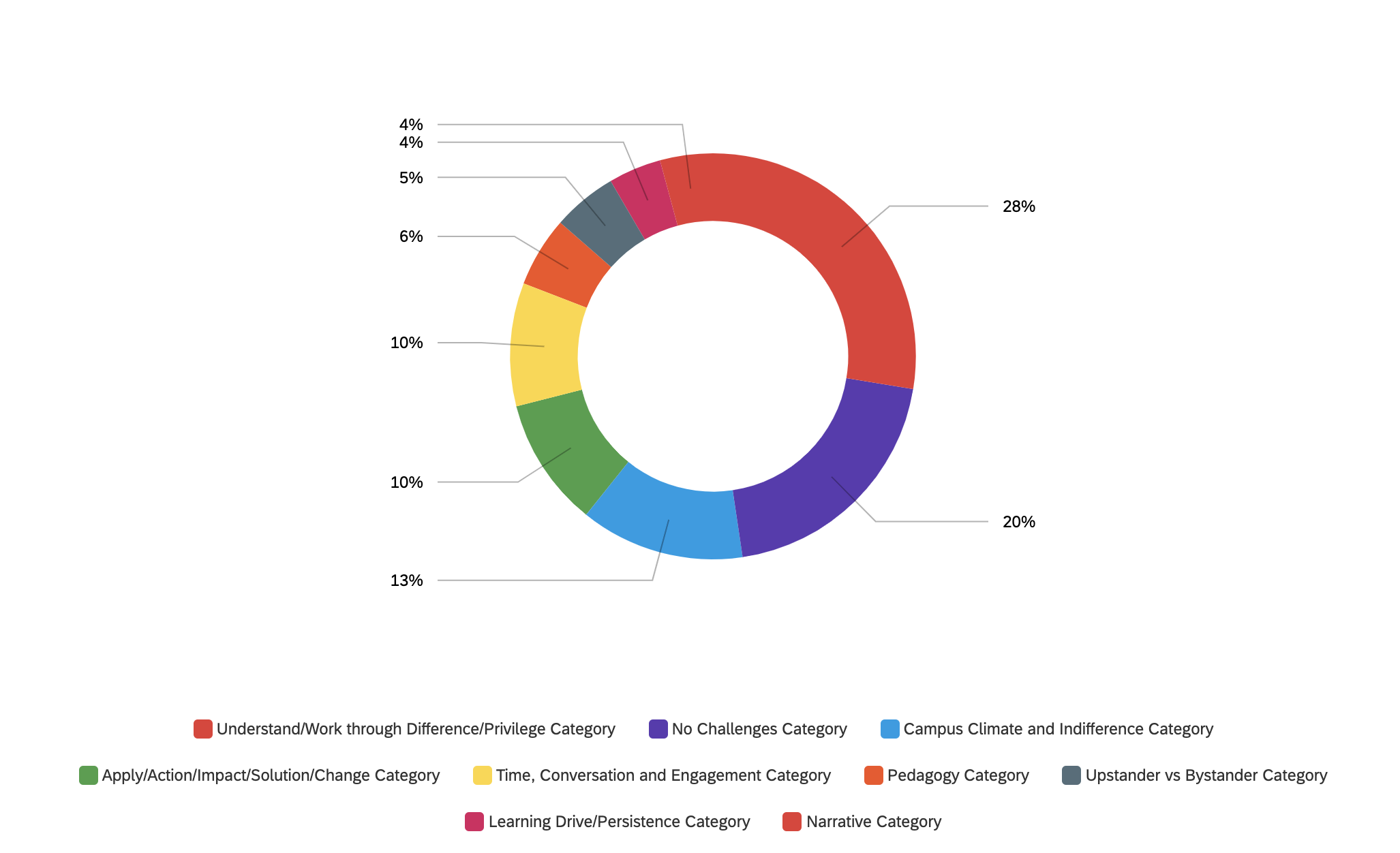
- 28% Understand/Work through Difference/Privilege
- 13% Campus Climate and Culture of Indifference
- 10% Apply/Action/Impact/Solution/Change
- 10% Time, Conversation and Engagement
- 6% Pedagogy
Understand/Work through Difference/Privilege. While 20% of the respondents didn’t raise any concerns, the majority of students expressing challenges in DSJ learning reflected on their journeys and acknowledged their privilege while also explaining how they find it hard navigating how to face this privilege and work through differences. Three common denominators materialize from these reflections beginning with family upbringing, education prior to UD (particularly in a Catholic context), and identity development during college life. These quotes represent a sample of almost 60 responses articulating these same points in different ways:
- What challenges me most is constantly examining my own privilege in the ways that I did not think of previously.
- The thing that challenges me most is learning to be more aware of my own privilege as a white person in a predominantly-white school
- I feel that my own privilege challenges me the most. I am aware of it and it makes me uncomfortable in certain situations.
- The biggest challenge is addressing my own biases and recognizing how I unknowingly contribute to problems regarding social justice or diversity.
- I think what challenges me most is that I'm learning that I must keep putting myself in situations where I feel uncomfortable or where I am held accountable for my privilege and bias-- so that I can start to unlearn and grow out of the harmful ways I've been socialized as a white woman in America.
- I am challenged by it because I do not come from a place that taught about this as much so it is hard to wrap my mind around sometimes.
- Challenges I have had learning about diversity and social justice would be the way that my upbringing had different values that clashed with what I was learning at first.
- I think that I grew up in a very protected, white community and I wish I was more exposed to alternative viewpoints and racial/ethnic backgrounds
- I think what challenges me most is understanding that our world has more issues than it appears to the naked eye, and makes me mad that I did not learn about all of this until now!
Campus Climate and Culture of Indifference. Students’ reflections on campus climate exhibited strong compassion and sensitivity for the experiences of minoritized groups on campus whether among their peers or faculty.
- I think what challenges my learning about diversity and social justice is the lack of diversity within many of my classes, so many groups are not represented in class discussion. Even when there are a few students from minority backgrounds, I worry that they may not feel comfortable sharing their opinion or outlook because of that lack of diversity on campus. I think it is important that the school prioritizes diversity not only on the campus as a whole, but also within each specific major because I have noticed that some classes or departments have more groups represented than others.
- One concern is the lack of diversity amongst faculty. It would be helpful to learn from faculty who are directly impacted by structures of inequality.
- There is a large group of students who do not take it seriously and think it is a "liberal agenda"
- Students who aren't in the humanities/social sciences are somewhat difficult to reach, and it is difficult to hear from them on their opinions
- My main concern is that there are people on this campus who are very closed off to people different than them, leading to discrimination based on people's race, sexual orientation, views etc.
Apply/Action/Impact/Solution/Change. A common thread that surfaced conjointly with the challenges to face privilege and differences is the action/application dimension of DSJ learning. Respondents underscored the importance of the conversations and how it’s an eye-opening, awareness raising experience, but they also asked for more. They showed eagerness to dig deeper in the content presented, especially in a way that allows them to learn about and utilize tools to apply such learning and make a change in their own lives or those they stand in solidarity with. These quotes capture some of these perspectives:
- I am most challenged by putting what I learn into action.
- I understand the challenges about transgender women in sports, but I'm struggling to find a solution.
- The biggest challenge for me as I learn about diversity and social justice is not knowing what actions I can take/hoping that my actions will help in some way to reduce discrimination and racism.
- I have learned a lot about the topics but not really how to be an ally to those in need.
- The challenge to me is finding equitable solutions. I know teachers aren't meant to give you all the answers, but some more direction for where to go would be appreciated at least by me.
- I guess the biggest challenge I have with learning about diversity is the fact that many conversations that are had never seem to lead to action. I would like to learn how to do more than just discuss issues and to be able to have an actual impact fixing these problems.
While standing as a theme on its own, being upstander vs. bystander contributes to this category by 5% of respondents expressing challenges in not knowing what or how to engage even when willing to do so:
- What challenges me most is calling people out when they are discriminating or giving microaggressions.
- What challenges me most is learning how to use my voice when things happen around me.
Time, Conversation and Engagement. Adding to the pattern of skills needed to apply to DSJ learning, respondents found it often difficult to engage in conversations whether in classroom (time constraints) or outside the course settings:
- I often have a hard time entering the conversation, I find it easy to listen to what others have to say, but I can be shy when it comes to entering the conversation
- I would say that the most difficult part about diversity/social justice is being willing to step out of your comfort zone to be able to have conversations about stuff you might be ignorant about/have less knowledge about.
- What challenges me the most is how to talk about these issues outside of class without offending anyone or saying the wrong thing. It is also challenging because I want to help but do not know exactly how to do that.
Pedagogy. While the questions around classroom experience provide in greater detail what constitutes an impactful learning experience, certain challenges were raised in this section. Some revolve around the course not delving deeper into DSJ elements, and instead making broad connections to these dimensions or not providing practical skills that lead to application and advocacy. Students also highlighted the importance and challenges of continuous learning and finding resources to persist in the DSJ learning space beyond the completion of the course. Coupled with the pedagogy angle, this adds up to 10% of respondents identifying the need to acquire skills to continue on this self-learning journey beyond the designated DSJ Course.
-
DSJ Pre-Course Design
Utilizing the Continuum as a framework during the design and development of DSJ courses to center practice-oriented skills and tools.
-
DSJ Post-Course Design
Practicing DSJ course assessments drawn from the Continuum to evaluate students' retention of the desired course learning objectives.
-
DSJ Learning & Other Spaces
A careful examination of how (co)-curricular experiences can intentionally and explicitly connect to Diversity ILG and DSJ learning.
Pre-Course Design
- As part of their plan to implement the Diversity ILG Continuum, the Academic Policies Committee (APC) of the Senate in consultation with CAP Committee (CAPC) will require faculty interested in designing new DSJ Courses to consult with the DSJ Coordinator to discuss their desired Continuum dimensions. This would help bring a cohesion to the DSJ courses as a unified advanced-level outcome aiming to engage advanced competencies, but more importantly align learning closely with the Diversity ILG efforts.
- While course content will vary given the creative premise of DSJ courses and the comprehensive nature of the Continuum, self-development and self-reflection are both necessary in the course design process. Faculty should utilize tools (to be created and drawn from the assessment itself and the Diversity ILG Learning Continuum) that would guide them in developing their course learning objectives and aligning them with the Diversity ILG.
- Similarly, School/Unit-level committees reviewing CAP course proposals should utilize tools (to be created and drawn from the assessment itself and the Diversity ILG Learning Continuum) that would guide them in providing constructive and cohesive feedback to the faculty developing the course, and aligning these efforts with the Diversity ILG at large.
Post- Course Design
- Newly designed/approved CAP DSJ courses will be expected to administer the CAP DSJ assessment at least in the first year the course is offered. This would provide the faculty with ongoing self-development professional opportunities to test how the course is resonating with the students and adapt accordingly to achieve the desired course learning objectives, and support their 4-year review assessment materials.
- School/Unit-level review bodies, such as the Academic Affairs Committee in the College of Arts and Sciences, are the first review checkpoint for the course design and review process. Membership of these bodies play a critical role in advancing the efforts of ILGs’ implementation at large and DSJ learning specifically. To continue moving this work forward, the Academic Policies Committee (APC) of the Senate in consultation with the CAP Committee (CAPC) needs to determine the best path for approving CAP DSJ courses in conjunction with the Diversity ILG Continuum: either implementing a new review group specifically for these course, or strengthening the capacity of existing School/Unit-level review bodies in understanding the intricacies of the Continuum, especially as more DSJ courses are being proposed and offered in professional Schools in addition to the College of Arts and Sciences.
It is critical to examine the question of “where diversity learning is happening?” in order to strengthen the value and contributions of CAP DSJ Courses. From a scaffolding perspective and in light of the information provided by the Mapping team of this working group, better understanding the landscape of (co)-curricular opportunities could meaningfully enhance the DSJ course learning experience. While Housing and Residence Life as well as Student Engagement on campus encompass a significant portion of such learning, it is critical to highlight the low engagement levels represented in this survey by Centers and Institutes with missions to advance Diversity ILG through various venues including research, advocacy and experiential learning opportunities. With Campus Recreation, MEC and Campus Ministry leading among the 6% respondents, less than 1% identified the Brook Center, Human Rights Center and Study Abroad as venues for such learning. A careful examination of how (co)-curricular learning can intentionally and explicitly connect to DSJ learning specifically and/or Diversity ILG efforts at large is necessary. These aspects should be an intentional component of any conversations that occur regarding building stronger links between curricular and (co)-curricular work moving forward.
Opportunities : Growth & Improvement
CAP DSJ provides faculty with a sandbox to channel their creative talents and passionate interests, while simultaneously enriching diversity learning offerings at the University. Supporting faculty development in this arena is critical to enhance both pedagogy and impact, and there’s an opportunity to reframe the DSJ narrative by centering the Continuum in conjunction with the student learning experiences. Drawing from the challenges presented in this assessment, there’s an eagerness for hopeful, change-making, solution, practice and action-driven learning outcomes articulated by our students. The desire for action often prefaces knowledge of self and others, which tends to replicate problems (particularly when driven by paternalism and/or the white savior complex).
The Continuum frames these goals through three levels ranging from understanding of key terms and definitions, to development of skills needed, to application of skills and knowledge. Pursuing this work in a cumulative, developmental way would provide the students enrolled in DSJ courses with the Advanced knowledge and tools to confidently engage in the space and enhance and renew the existing range of DSJ course offerings, but, more importantly, it would make Diversity ILG language accessible to faculty across schools and units incentivizing them to pilot and experiment designing new courses. To do this work effectively, we need to not only strengthen the role the Diversity ILG plays in CAP, but also build ongoing educational opportunities for faculty and staff to keep us moving forward.
“When I was talking [sic] with all of my friend group one night, we all got into a huge fight about exploring our own privileges and acknowledging the elephant in the room that we only had one black friend in our friend group, of whom was most of our friends' first black friend. While this conversation was more of a dispute I think I was able to be helpful and help guide the conversation in a better direction because of the courses and things I have learned within the CAP program.”
Student Reflection, DSJ Course Spring 2021
